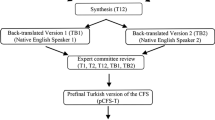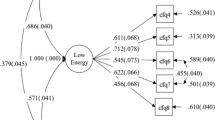Abstract
Socioeconomic status explains many ethnic disparities in health; however, mechanisms are hard to identify. Fatigue—a frequent complaint in patients and normals—is associated with poorer quality of life. We wondered if ethnicity and social class interact to explain fatigue. A total of 40 African Americans (AAs) and 64 Caucasian Americans (CAs) completed short forms of the Profile of Mood States (POMS-SF) and Multidimensional Fatigue Symptom Inventory (MFSI-SF). Participants were divided into high-middle and low social class groups (as per Hollingshead, 1958a). After controlling for gender, body mass index, depressive symptoms, and response bias, ethnicity and social class interacted for POMS-SF fatigue. AAs in the high-middle classes reported more fatigue than AAs in the low classes and CAs in the high-middle classes. Fatigue did not differ by class for CAs nor by ethnicity in the lower classes. Similar findings emerged for MFSI-SF general fatigue. Social class is important for understanding fatigue in AAs but not CAs.
Similar content being viewed by others
References
Adler, N. E., & Snibbe, A. C. (2003). The role of psychosocial processes in explaining the gradient between socioeconomic status and health. Current Directions in Psychological Science, 12, 119–123.
Anderson, N. B., & Armstead, C. A. (1995). Toward understanding the association of socioeconomic status and health: A new challenge for the biopsychosocial approach. Psychosomatic Medicine, 57, 213–225.
Bardwell, W. A., & Dimsdale, J. E. (2001). The impact of ethnicity and response bias on the self-report of negative affect. Journal of Applied Biobehavioral Research, 6, 27–38.
Bardwell, W. A., & Dimsdale, J. E. (2004). Ethnic differences in the experience of fatigue and the willingness to report it. Psychosomatics, 45, 146.
Bardwell, W. A., Moore, P., Ancoli-Israel, S., & Dimsdale, J. E. (2000). Does obstructive sleep apnea confound sleep architecture finding in subjects with depressive symptoms? Biological Psychiatry, 48, 1001–1009.
Bardwell, W. A., Moore, P. J., Ancoli-Israel, S., & Dimsdale, J. E. (2002). Social class is associated with fatigue in obstructive sleep apnea. Annals of Behavioral Medicine, 24, 144.
Bardwell, W. A., Moore, P. J., Ancoli-Israel, S., & Dimsdale, J. E. (2003). Fatigue in obstructive sleep apnea: Driven by depressive symptoms instead of apnea severity? American Journal of Psychiatry, 160, 350–355.
Bowsher, J. E., & Gerlach, M. J. (1990). Personal control and other determinants of psychological well-being in nursing home elders. Scholarly Inquiry for Nursing Practice, 4, 91–108.
Broman, C. L., Mavaddat, R., & Hsu, S. (2000). The experience and consequences of perceived racial discrimination: A study of African Americans. Journal of Black Psychology, 26, 165–180.
Brown, C., Schulberg, H. C., & Madonia, M. J. (1996). Clinical presentations of major depression by African Americans whites in primary medical care practice. Journal of Affective Disorders, 41, 181–191.
Callahan, C. M., & Rivara, F. P. (1992). Urban high school youth and handguns: A school-based survey. Journal of the American Medical Association, 267, 3038–3042.
Cockram, A., Judd, F. K., Mijch, A., & Norman, T. (1999). The evaluation of depression in inpatients with HIV disease. The Australian and New Zealand Journal of Psychiatry, 33, 344–352.
Crowne, D. P., & Marlowe, D. (1960). A new scale of social desirability independent of psychopathology. Journal of Consulting Psychology, 24, 349–354.
Curran, S. L., Andrykowski, M. A., & Studts, J. L. (1995). Short form of the Profile of Mood States (POMS-SF): Psychometric information. Psychological Assessment, 7, 80–83.
Dimsdale, J. E., & Newton, R. P. (1992). Cognitive effects of beta blockers. Journal of Psychosomatic Research, 36, 229–236.
Dressler, W. W., Bendon, J. R., & Negger, Y. H. (1998). John Henryism, gender, and arterial blood pressure in an African American community. Psychosomatic Medicine, 60, 620–624.
Fisher, G. (1967). The performance of male prisoners on the Marlowe-Crowne Social Desirability Scale-II: Differences as a function of race and crime. Journal of Clinical Psychology, 23, 473–475.
Fletcher, A. E., Bulpit, C. J., Chase, D. M., Collins, W. C., Furberg, C. D., & Gogin, T. K. (1992). Quality of life with three antihypertensive treatments: Cilazapril, atenolol, nifedipine. Hypertension, 19, 499–507.
Gary, L. E. (1995). African American men’s perceptions of racial discrimination: A sociocultural analysis. Social Work Research, 19, 207–217.
Hollingshead, A. B. (1958a). Two factor index of social position. New Haven, CT: Yale University Press.
Hollingshead, A. B. (1958b). Social class and mental illness. New York: Wiley.
James, S. A., Keenan, N. L., Strogatz, D. S., Browning, S. R., & Garrett, J. M. (1992). Socioeconomic status, John Henryism, and blood pressure in black adults: The Pitt County study. American Journal of Epidemiology, 135, 59–67.
Jason, L. A., Jordan, K. M., Richman, J. A., Rademaker, A. W., Huang, C. F., & McCready, W. (1999). A community-based study of prolonged fatigue and chronic fatigue. Journal of Health Psychology, 4, 9–26.
Jason, L. A., Taylor, R. R., Kennedy, C. L., Jordan, K., Song, S., & Johnson, D. E. (2000). Chronic fatigue syndrome: Sociodemographic subtypes in a community-based sample. Evaluation and the Health Professions, 23, 243–263.
Klonoff, E. A., & Landrine, H. (1994). Culture and gender diversity in commonsense beliefs about the causes of six illnesses. Journal of Behavioral Medicine, 17, 407–418.
Kraus, J. F., Borhani, N. O., & Franti, C. E. (1980). Socioeconomic status, ethnicity, and risk of coronary heart disease. American Journal of Epidemiology, 111, 407–414.
Lichstein, K. L., Means, M. K., Noe, S. L., & Auillard, R. N. (1997). Fatigue and sleep disorders. Behavioral Research Therapies, 35, 733–740.
Lieberman, H. R., Wurtman, J. J., & Teicher, M. H. (1989). Aging, nutrient choice, activity, and behavioral responses to nutrients. Annals of the New York Academy of Science, 561, 196–208.
Lotstein, D. S., Ward, M. M., Bush, T. M., Lambert, R. E., Van Vollenhoven, R., & Neuwelt, C. M. (1998). Socioeconomic status and health in women with systemic lupus erthematosus. Journal of Rheumatology, 25, 1720–1729.
McNair, D. M., Lorr, M., & Droppleman, L. F. (1992). POMS manual: Profile of mood states. San Diego, CA: Educational and Industrial Testing Service.
Metropolitan Life Foundation. (1983). Metropolitan height and weight tables. Statistics Bulletin of the Metropolitan Life Found, 64, 3–9.
Paulhus, D. L. (1984). Two-component models of socially desirable responding. Journal of Personality and Social Psychology, 46, 598–609.
Radloff, L. S. (1977). The CES-D scale: A self-report depression scale for research in the general population. Journal of Applied Psychological Measurement, 1, 385–401.
Silas, J., Barker, A., & Ramsay, L. (1980). Clinical evaluation of Dinamap 845 automated blood pressure recorder. British Heart Journal, 43, 202–205.
Steele, L., Dobbins, J. G., Fukuda, K., Reyes, M., Randall, B., Koppelman, M., et al. (1998). The epidemiology of chronic fatigue in San Francisco. American Journal of Medicine, 105, 83–90.
Stein, K. D., Jacobsen, P. B., Blanchard, C. M., & Thors, C. (2004). Further validation of the Multidimensional Fatigue Symptom Inventory-Short Form (MFSI-SF). Journal of Pain and Symptom Management, 27, 14–23.
Stein, K. D., Martin, S. C., Hann, D. M., & Jacobsen, P. B. (1998). A multidimensional measure of fatigue for use with cancer patients. Cancer Practice, 6, 143–152.
Tanaka-Matsumi, J., & Kameoka, V. A. (1986). Reliabilities and concurrent validities of popular self-report measures of depression, anxiety, and social desirability. Journal of Consulting and Clinical Psychology, 54, 328–333.
Taylor, R. R., Leonard, A., & Jahn, S. C. (2003). Chronic fatigue and sociodemographic characteristics as predictors of psychiatric disorders in a community-based sample. Psychosomatic Medicine, 65, 896–901.
Torres-Harding, S. R., Jason, L. A., & Taylor, R. R. (2001). Fatigue severity, attributions, medical utilization, and symptoms in persons with chronic fatigue. Journal of Behavioral Medicine, 25, 99–113.
Yu, B. H., Nelesen, R., Ziegler, M. G., & Dimsdale, J. E. (2001). Mood states and impedance cardiography-derived hemodynamics. Annals of Behavioral Medicine, 23, 21–25.
Yunus, M. B., Arslan, S., & Aldag, J. C. (2002). Relationship between body mass index and fibromyalgia features. Scandinavian Journal of Rheumatology, 31, 27–31.
Author information
Authors and Affiliations
Corresponding author
Additional information
This work was supported by National Institutes of Health grants HL36005 and RR00827.
Rights and permissions
About this article
Cite this article
Bardwell, W.A., Burke, S.C., Thomas, K.S. et al. Fatigue varies by social class in african americans but not caucasian americans. Int. J. Behav. Med. 13, 252–258 (2006). https://doi.org/10.1207/s15327558ijbm1303_9
Issue Date:
DOI: https://doi.org/10.1207/s15327558ijbm1303_9




